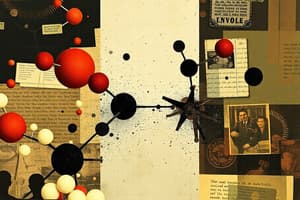Podcast
Questions and Answers
Which of the following describes a characteristic of non-competitive inhibitors?
Which of the following describes a characteristic of non-competitive inhibitors?
- They can decrease the Vmax. (correct)
- They are permanently bound to the enzyme.
- They increase the affinity of the enzyme for the substrate.
- They bind to the active site of the enzyme.
Allosteric inhibitors bind to the active site of enzymes to alter their activity.
Allosteric inhibitors bind to the active site of enzymes to alter their activity.
False (B)
What is the role of ATP in glycolysis concerning phosphofructokinase?
What is the role of ATP in glycolysis concerning phosphofructokinase?
ATP acts as an allosteric inhibitor of phosphofructokinase.
In feedback inhibition, the end product inhibits the activity of an _____ enzyme.
In feedback inhibition, the end product inhibits the activity of an _____ enzyme.
Match the type of enzyme inhibition with its description:
Match the type of enzyme inhibition with its description:
Which of the following statements is true about competitive inhibitors?
Which of the following statements is true about competitive inhibitors?
Non-competitive inhibitors can be reversed by increasing substrate concentration.
Non-competitive inhibitors can be reversed by increasing substrate concentration.
What is the primary characteristic of allosteric inhibitors?
What is the primary characteristic of allosteric inhibitors?
_____ and Warfarin are anticoagulants that act as competitive inhibitors.
_____ and Warfarin are anticoagulants that act as competitive inhibitors.
Match the following drugs with their function as enzyme inhibitors:
Match the following drugs with their function as enzyme inhibitors:
What does an increase in Km indicate in the presence of a competitive inhibitor?
What does an increase in Km indicate in the presence of a competitive inhibitor?
Irreversible inhibitors bind permanently to the enzyme, making enzyme activity permanently inactive.
Irreversible inhibitors bind permanently to the enzyme, making enzyme activity permanently inactive.
Define non-competitive inhibitors.
Define non-competitive inhibitors.
Flashcards
Competitive Enzyme Inhibitors
Competitive Enzyme Inhibitors
Molecules that resemble the substrate and bind to the enzyme's active site, preventing the substrate from binding.
Non-competitive Enzyme Inhibitors
Non-competitive Enzyme Inhibitors
Inhibitors that bind to an enzyme at a site other than the active site, altering its shape and preventing substrate binding.
Enzyme Inhibition
Enzyme Inhibition
The process where a molecule (inhibitor) reduces or stops the activity of an enzyme.
Competitive Inhibitor Example - Sulfanilamide
Competitive Inhibitor Example - Sulfanilamide
Signup and view all the flashcards
Competitive Inhibitor Example - Allopurinol
Competitive Inhibitor Example - Allopurinol
Signup and view all the flashcards
Competitive Inhibitor Example - Statins
Competitive Inhibitor Example - Statins
Signup and view all the flashcards
Effect of Competitive Inhibitor on Km
Effect of Competitive Inhibitor on Km
Signup and view all the flashcards
Effect of Competitive Inhibitor on Vmax
Effect of Competitive Inhibitor on Vmax
Signup and view all the flashcards
Allosteric inhibitor
Allosteric inhibitor
Signup and view all the flashcards
Allosteric inhibition example
Allosteric inhibition example
Signup and view all the flashcards
Competitive inhibition
Competitive inhibition
Signup and view all the flashcards
Reversible enzyme inhibition
Reversible enzyme inhibition
Signup and view all the flashcards
Study Notes
Enzyme Inhibition - Lecture Notes
- Lecture Objectives:
- Explain different types of enzyme inhibition.
- Compare reversible competitive and non-competitive enzyme inhibitors, and allosteric inhibitors.
- List examples of drugs acting as enzyme inhibitors in clinical practice.
Types of Enzyme Inhibition
-
Reversible Inhibition:
- Competitive Inhibition:
- Structural similarity between substrate and inhibitor.
- Both compete for the active site.
- Relative concentration affects inhibition.
- Increased substrate concentration reverses inhibition.
- Km increases, Vmax remains constant.
- Slope of Lineweaver-Burk plot increases.
- Example: Sulfanilamide (bacteriostatic), statins (inhibit HMG-CoA reductase, used for hypercholesterolemia),
- Non-competitive Inhibition:
- No structural similarity between substrate and inhibitor.
- No competition for active site.
- Inhibitor binds to a site other than the active site, altering the enzyme's shape.
- Absolute inhibitor concentration affects inhibition..
- Not reversed by increased substrate concentration.
- Km remains constant, Vmax decreases.
- Slope of Lineweaver-Burk plot increases.
- Example: Captopril (ACE inhibitor, used for hypertension).
- Allosteric Inhibition:
- Small organic molecules bind to an allosteric site on the enzyme.
- This causes a conformational change, making it less suitable for binding to the substrate.
- Decreases enzyme activity.
- Km increases, Vmax decreases.
- Example: ATP (inhibits phosphofructokinase).
- Competitive Inhibition:
-
Irreversible Inhibition:
- Cofactor/coenzyme disruption.
- Denaturation/precipitation.
- SH group modification.
- Anti-enzyme formation.
Competitive Inhibitors (Substrate Analogues)
- Mechanism of action:
- Competitive inhibitors have a structure similar to the substrate.
- They compete with the substrate for binding to the active site.
- When the inhibitor binds, the enzyme can't bind to the substrate and no product is made.
- The amount of inhibition depends on the relative concentrations of substrate and inhibitor
Non-competitive Inhibitors
- Mechanism of action:
- Non-competitive inhibitors bind to a site other than the active site and alter the enzyme's shape.
- This changes the active site, preventing the substrate from binding effectively.
- The inhibition is not reversible by increasing substrate concentration.
Allosteric Inhibitors
- Mechanism of action:
- These inhibitors bind an allosteric site.
- The binding induces a conformational change altering the active site.
- This impacts the enzyme's ability to bind its substrate (and hence catalyze a reaction).
Studying That Suits You
Use AI to generate personalized quizzes and flashcards to suit your learning preferences.





